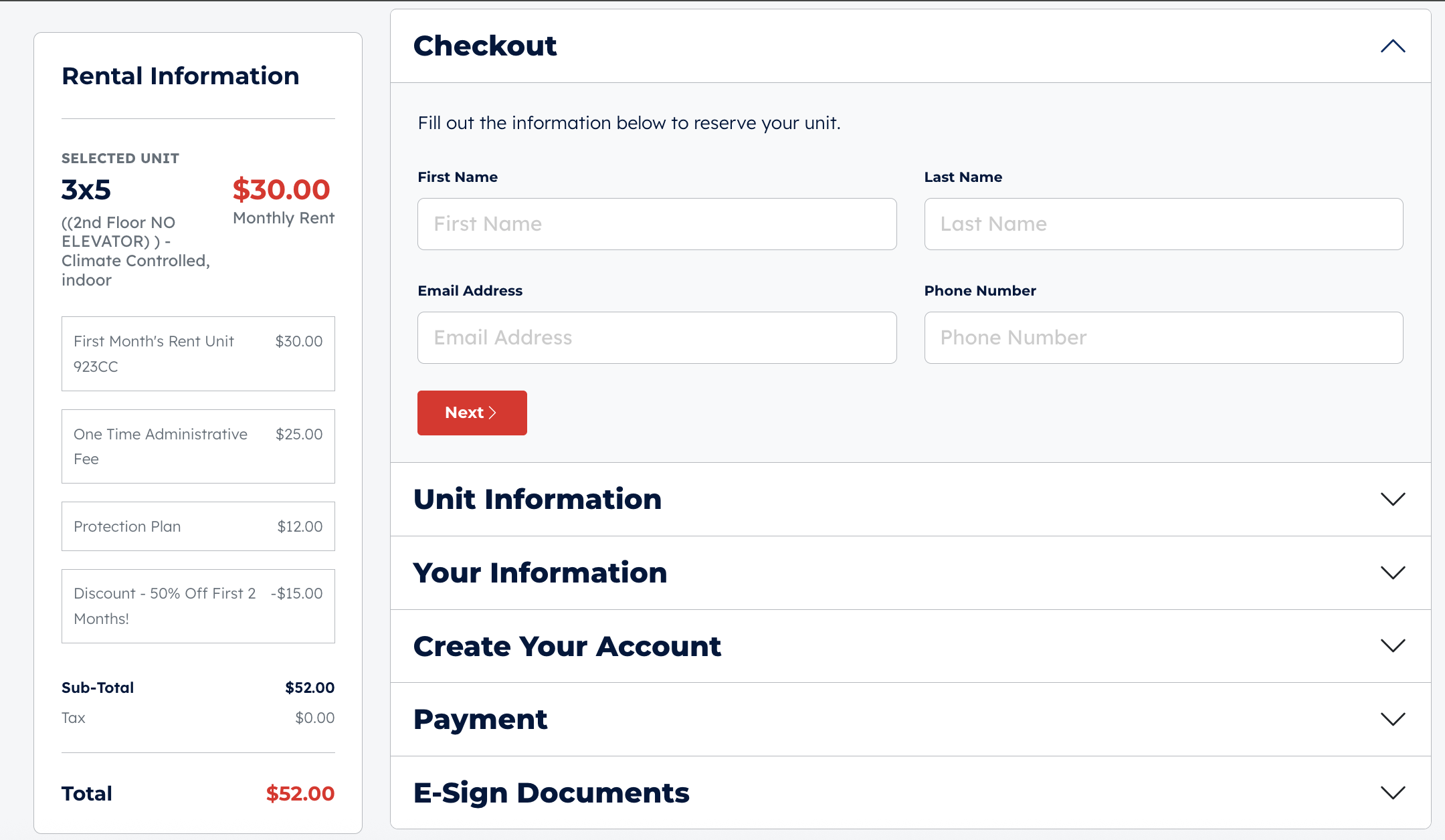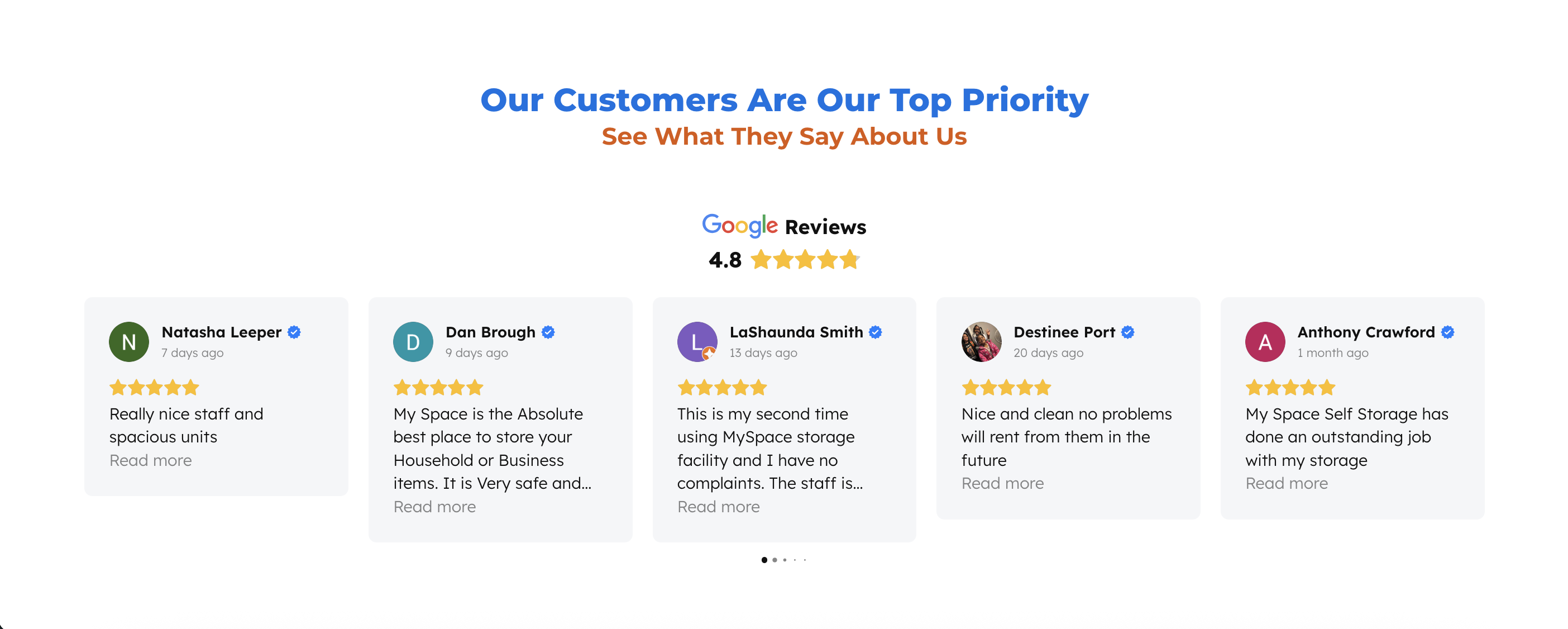
There are millions of self storage-related searches per month, and the facilities with the best websites are turning those searchers into customers.
Self storage may be a hyperlocal business, but in an era of digital-first shopping, your website is often the first (and sometimes only) interaction prospective tenants have with your business.
Yet, many storage operators still rely on outdated sites that look fine on a visual level but fail at the one job that really matters: converting visitors into rentals. In short, if your website isn’t offering a streamlined rental experience, you’re probably losing potential customers.
As a third-party manager, we’ve analyzed hundreds of storage websites across markets in 40 states. The difference between effective self storage websites and average ones isn’t a mystery. It comes down to a few key areas, like structure, content, and experience design.
Here are the five components that consistently separate high-converting storage websites from the rest.

If your website makes customers call or email to rent a unit, you’re leaving money on the table.
From selecting a unit to signing a lease and paying the first month’s rent, renters now expect to complete the entire rental process online.
This is due to a phenomenon known as liquid expectations. Once people have a best-in-class experience, they judge all subsequent experiences by that standard. Essentially, potential tenants are comparing how easily they can rent a unit to how easily they can order from Amazon.
That means your website should feel less like a brochure and more like an e-commerce checkout.
Prominent “Rent Now” and “Reserve” buttons
People love simplicity, so make it as easy as possible for website visitors to get started. Put calls to action (CTAs) to start the rental process on every page and in the main navigation of your website.
Limit the number of clicks
The more someone has to click, the more difficult they perceive the experience. Renting a storage unit will always be a multi-step process, but whenever possible, reduce the amount of clicks for your users so they’ll be more likely to complete the process.
Mobile-first design
Roughly 45% of all web traffic in the United States is from mobile devices. While that number will vary by industry, it means a significant portion of your website visitors will be using their phones.
Make sure your website design is responsive, meaning it will adjust to deliver an optimal experience for mobile users.
Visualize the next steps
Progress is motivating. So when people can see how many steps are left in the checkout process, they’re more likely to finish because they understand what they have left to do.
Here’s an example from one of our client’s sites:

Today’s customers expect transparency. They want to compare sizes, prices, and promotions instantly. When they can’t, they bounce, and they’re often going straight to a competitor who provides the information upfront.
High-converting websites use:

Even small tweaks can make a big impact at this stage. For example, displaying unit availability when stock is low (“3 left at this price”) can have a meaningful impact on conversion rates.
In storage, credibility is everything. One of the best ways to build trust is through reviews, which is a powerful form of social proof.
People are almost always more likely to follow the recommendations of people they trust, which is why word of mouth remains one of the most effective forms of advertising.
Reviews are the next best thing because they signal that people trust and appreciate your facility and would recommend it to others. Customer reviews will display in your Google Business Profile (GBP) but you should also make sure to give them prominent placement on your homepage.

When a prospective tenant sees a slew of positive reviews, it sets their mind at ease and makes them more likely to choose your facility.
Beyond reviews, there are other ways to build trust using your website:
People have a very low tolerance for slow-loading pages. Research shows that a one-second delay in load time can reduce conversions by up to 20%. If your site doesn’t load quickly, people will leave.
Likewise, search engines like Google and Bing penalize sluggish websites by ranking them lower in search results. That’s why technical performance and SEO fundamentals matter as much as design.
Technical SEO can get complicated fast, but here are a few best practices to ensure your pages load quickly and your site ranks effectively:
If you want to get a high-level rundown of how your website performs now, you can use Google’s PageSpeed Insights tool to get a free report.
Fixing these issues can be complicated, so it’s often better to hire a self storage marketing company to handle backend SEO and site speed problems.
Images That Show Off Your Facility
Photography matters, and a set of clean, high-definition images on your website indicates that your facility is well-maintained and secure.
On the other hand, outdated design, grainy photos, or inconsistent branding can make potential renters second-guess their decision, particularly when they’re trusting you with their belongings.
Whether you’re a drive up facility or a multi-level A class property, it’s worth the investment for high-quality photos.
Like reviews, it’s best to display images of your facility on your homepage so visitors don’t have to search them and can immediately get an impression of your property.
Content That Answers Questions
Adding a Frequently Asked Questions (FAQ) can be a key component to improving conversions. Why? Because people don’t have to scour your site or reach out to facility staff to get the answers they want to important questions.
If there’s one critical question that’s holding back a potential customer from renting, providing the answer in an easy-to-understand format can alleviate their anxiety and help them move forward in the rental process.
Your self storage website is more than a sales brochure; it’s a revenue engine. When it’s built for conversions, it can help you earn money in your sleep.
The best part? You don’t have to build it alone.
White Label Storage designs, builds, and manages high-performing websites for self storage operators across the country.
Every site we launch is optimized for conversions, integrated with your management software, and backed by the same operational insights we use to run over 300 facilities nationwide.
If your website isn’t pulling its weight, or if you’re tired of wondering how many rentals you’re missing, let’s fix that. Schedule a demo with our team today.